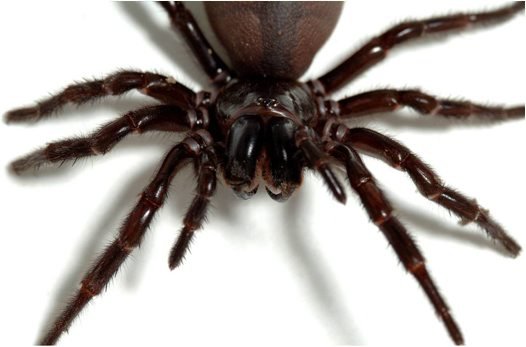Sydney Funnel-web Spider
Sydney Funnelweb Spider, Funnel Web Spider
Probably the most notorious of all spiders, Sydney Funnel-webs have a fearsome reputation. Most of this is deserved, but some is exaggerated.
Identification
Sydney Funnel-webs are shiny, dark brown to black spiders with finger-like spinnerets (silk-spinning organs) at the end of their abdomen. Males have a large mating spur projecting from the middle of their second pair of legs. If threatened, Sydney Funnel-webs show aggressive behaviour, rearing and displaying their impressive fangs.

© Australian Museum
Habitat
Urban areas and forests.
Stay in the know
Get our monthly emails for amazing animals, research insights and museum events
Sign up todayDistribution
The Sydney Funnel-web Spider (Atrax robustus) occurs in New South Wales, from Newcastle to Nowra and west to Lithgow. They especially favour the forested upland areas surrounding the lower, more open country of the central Cumberland Basin. This includes the Hornsby Plateau to the north, the foothills of the Blue Mountains to the west, and the Woronora Plateau to the south. Funnel-web occurrence is low in much of central-western Sydney, and also the sandy coastal parts of the eastern suburbs and the Botany Bay area. They do better in areas of sandy clay, shale or basaltic soils that can retain moisture more effectively.
Feeding and diet
Funnel-webs burrow in sheltered sites under logs and rocks where they can find a cool and humid climate. Funnel-webs rush out of their burrow when potential prey, such as beetles, cockroaches, small lizards or snails, walk across silken trip-lines that the spider has placed around the outside of its burrow. They then return to their burrow to eat their meal.

Male Sydney Funnel-web Spider (Atrax robustus) approaching female to mate.
Image: Mike Gray© Australian Museum
Other behaviours and adaptations
Male Sydney Funnel-web spiders have a habit of wandering into backyards and falling into suburban swimming pools, where they can survive many hours. They also sometimes enter and become trapped in houses. Again, it is true that Sydney Funnel-webs have one of the most toxic venoms (to humans) of any spider. However, it is not true that all funnel-web bites are life-threatening. The venom of juvenile and female Sydney Funnel-web Spiders is much less toxic. Nor do they jump onto, or chase people, or live in houses - these are all urban myths.
Dry daytime surface conditions will dehydrate funnel-web spiders and also expose them to birds and lizards. This is why males that have spent the night in search of a female have to seek cover at dawn. This can be any suitable hideaway that is dark, moist and cool, like a cavity under a rock, or even in a shoe left outdoors.
A number of other spiders are often mistaken as funnel-webs, including mouse spiders, trapdoor spiders and even Black House Spiders.
Breeding behaviours
Males leave their burrows and wander over summer and autumn to find females and mate.
Danger to humans
Funnel-web bites are dangerous and first aid should be given immediately using the pressure bandage/immobilisation technique (as for snake bite) and the victim taken to hospital and given antivenom if necessary. The venom has a neurotoxin component that attacks the human nervous system and, in the worst cases, can result in death. However, there have been no fatalities since the introduction of antivenom.
References
- McGhee, K. 1999. Funnel-webs, Aust. Geog. 53: 80-95
- Gray, M. 1992. Funnel Webs: separating fact from fiction, ANH 24(3): 32-39
- Meier, Dr. J and White, Dr. J. (eds) 1995. CRC Handbook of Clinical Toxicology of Animal Venoms and Poisons CRC Press Inc, Boca Raton, Florida, USA
- Gray, M. 1987. Distribution of the Funnel Web Spiders, in Covacevich, Davie & Pearn (eds), Toxic Plants and Animals: a guide for Australia: 313-21
- Gray, M. 1984. A guide to Funnel-web spider identification, The Medical Journal of Australia, December 8/22
- Gray, M. 1981 Getting to know Funnel Webs, ANH 20(8): 265-270


